Diablo 4's Season of the Malignant is a hell of my own making
Add-to-cart disease.
As an avid enthusiast of artful, purposeful suffering in games, returning to Diablo 4 for its first season seems, on the surface, like a joyful midnight binge at McDonalds: a hollow but familiar, mostly satisfying romp through your menu favourites, with useless tchotchkes that come with your meal, whether you want them or not. But once you hit endgame - I maxed out the entire season battle pass in a week - everything becomes a seemingly interminable period of digestive limbo. This constipatory hangover is usually marked by a series of revelations - I think I'm over it, they changed the recipe, this doesn't taste as good as it used to. But when season two arrives, we'll be back at the beginning of the cycle again, clamouring for the golden arches of hell to open for eager, optimistic, freshly-rolled Wanderers. For many Diablo players, including myself, this is the way.
It's true that Diablo has always been about the unending grind, but in season one, the tedium has never been so pronounced. At times, it felt more joyless than the spiritless farming and loot churn that was a defining part of Diablo 3. With all of the season pass treats pushed at me each time I do a little more, it often feels like I'm being trained on maximising my productivity and efficiency in a corporate rewards program or a gig worker job. Examining the new Diablo has largely been coming to terms with my relationship with the game and the way it meticulously replicates real-world gig economy bullshit, something that triple-A live-service games have always done to a degree, but now, the similarities feel downright pathological.
A short, somewhat generic questline introduces the seasonal Malignant theme to Sanctuary. It involves helping a fellow named Cormond tackle a new blight he calls the Malignant, which covers the land in sallow, glowing pustules. More specifically, it involves killing entumored Malignant monsters, collecting their hearts in special cages, and socketing them into jewellery for powerful buffs. These are best found in Malignant tunnels, a standalone dungeon system that requires the use of special items called invokers. This cancerous motif permeates Sanctuary, and the schtick of these Malignant creatures is that you basically have to kill them twice to obtain their caged hearts. Apart from the new season, there's also an encyclopaedia-length patch update, which includes quality of life improvements, class balancing, and other tweaks. Even as a longtime MMO player accustomed to the formalities of live-service games, after a certain point, poring over these notes is like trying to find meaning in a CVS receipt.
I start the season with the general understanding that a lot of classes have been nerfed, with sorcerer taking the brunt of the damage. I make a brand new rogue, and begin levelling via Whispers and side quests and running around to unlock waypoints. When I finally get to World Tier III, I hurl myself into Helltides and world events beyond my ability in the hopes that I'll get a few decent drops; the "real" grind for some people only starts in World Tier IV, where you farm the gear that actually stays with you (it's me, I'm one of those people). Being able to bypass the campaign is a blessing and a curse: this is arguably the most well-written Diablo story, but also unfathomably long and questionably paced - I cannot imagine having to do it a fourth time in three months.
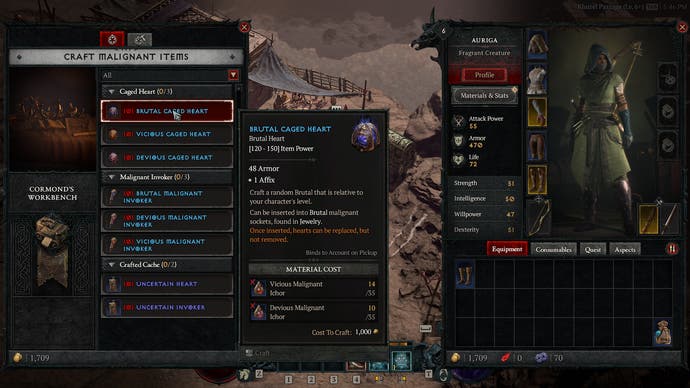
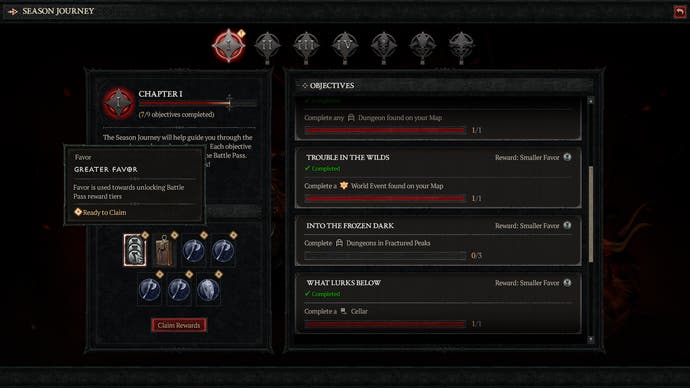
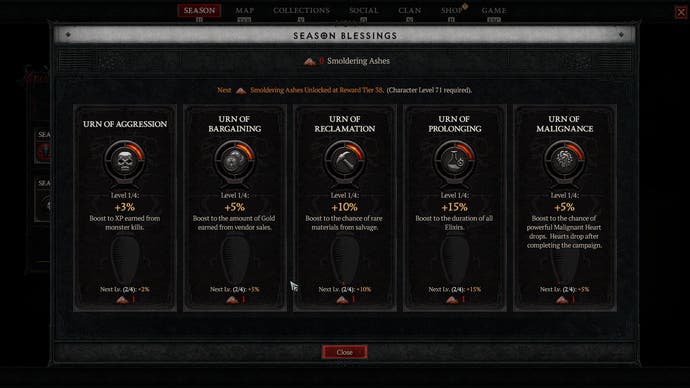
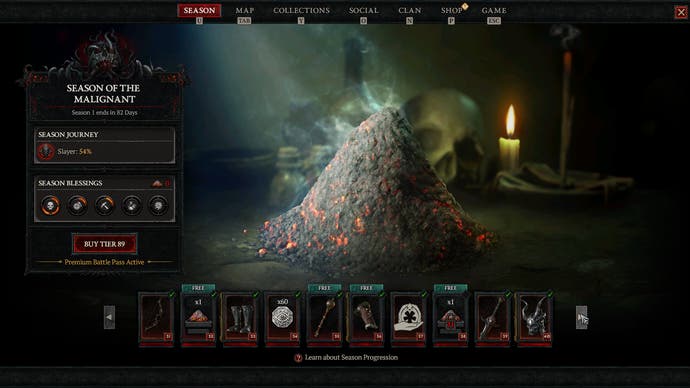
Then there's the actual seasonal content, which feels perplexingly like filler. After the initial novelty wore off, the Malignant dungeon system became mostly forgettable until I hit endgame and started earnestly farming for my best-in-slot Malignant hearts - a half-hearted (sorry) endeavour that didn't last long at all. The heart system was sort of compelling at first until it wasn't, and Cormond himself just fades back into the bushes of obscurity, doing inscrutable NPC things at his bench in Kyovashad. It'll be interesting to see if subsequent seasons build on previous narratives in some way, or if they're all weird little pockets of disaster like this one; either way, the campaign - one of the strongest parts of the game, warts and all - feels like a lifetime ago.
My biggest issue is the fact that it's season one and we're already having discussions about burning out. Like any newborn MMO, small frustrations will get addressed over time - Diablo 4 is an enormous game sitting on chaotic spaghetti-mountains of code, and must manage its relationship with, for better or worse, a very vocal and particular player base. But it's also the inevitable product of an AAA titan focused on the bottom line, which means that gacha-inspired lootboxes and paying for bad emotes are par for the course. Remember how Diablo 3's real-money auction house got taken out and shot behind the shed? That dream of injecting hyper-capitalism into the big nostalgic treasure-hunting game didn't die - it just got stored away for a more opportune reincarnation. Diablo 4 is a thing born of Fortnite and microtransactions and the last gasp of corporate America's hopes and dreams for a fruitful, functioning metaverse, where the economy and labour and entertainment intersect to invent new cottage industries that belong in Neal Stephenson's corniest book.
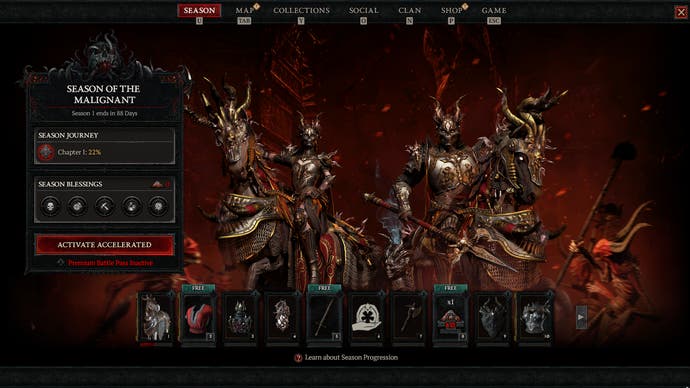
AAA games are above all a service to the player, but the service here, at least for me, is no longer the same kind of taut, bristling multiplayer adventure that defined my childhood. Seasonal territory is a vastly different creature, and the endgame, once you've done everything you want to do, is boring as hell, and the normal thing to do would be to stop. The game simply isn't designed that way. Not long after Diablo 4 launched, the devs reminded people to take a break and do something else. Even with the understanding that creative teams and business development aren't usually on the same page, there's a fascinating dissonance here between what should be healthy behavioural interaction with a video game, and the mechanical reality of how the game is designed to be an unmitigated timesink. If we feel like we're all working towards some kind of invisible goal, it's towards Blizzard execs being able to put nice fat numbers into an end-of-year keynote presentation. If playing Diablo 4 feels like work, it's because it borrows so much from tech-centric work infrastructure and psychology.
When I'm farming Whispers and gear, I'm trying to optimise my routes and hit as many objectives as possible in the same area, sort of like doing Instacart runs while also driving for Uber. There are exacting writeups on how to maximise XP gains and long detailed guides for paragon point allotments. Helltides.com is a crowdsourced fan site that helps players locate the rarest type of lootbox during Helltide, a recurring event where hell bleeds over into parts of Sanctuary. The site uses player input to predict where the most likely spawn points will be, sort of like how rideshare drivers help to call in car accidents to improve the user experience. The fully optimised Diablo 4 player constantly refers to third-party sites so that they can follow special farming routes or Helltide maps rather than read the environment and explore it naturally. While I do my string of errands around Sanctuary, as I rack up more inane battle pass rewards, I am reminded briefly of the infamous Hilton Garden Inn video game made for the PSP, an employee training simulator where newcomers would earn points for doing different jobs around the hotel. Diablo 4, at least for the committed lifer, is no longer a bloodthirsty romp through hell, but an unpaid feat of multitasking where your orbitofrontal cortex tries valiantly to reassure you that you are, in fact, having a great time while also being productive.
When it comes to my rogue, I'm only just barely having a good time. I wanted to play a ranged class, but it turns out the closest thing to a good endgame ranged rogue - the dualcore rapid-fire/flurry build - is still mostly a melee build. It's a great farming workhorse, and a brisk and engaging alternative to my previous character, the largely point-and-shoot ice-shards sorcerer. But when it comes to pushing nightmare dungeons, my preferred activity with friends, I simply can't get where I need to go unless I reroll to the current rogue meta. The cost, in terms of gold, time, and effort, is egregious - a perplexing frictive barrier between experimentation and organic player-made fun. Yes, it is the Blizzard way to funnel everyone into a handful of fashionably overpowered builds each season, but by god, I didn't always feel so trapped (is this a bad rogue joke? I'm so sorry).

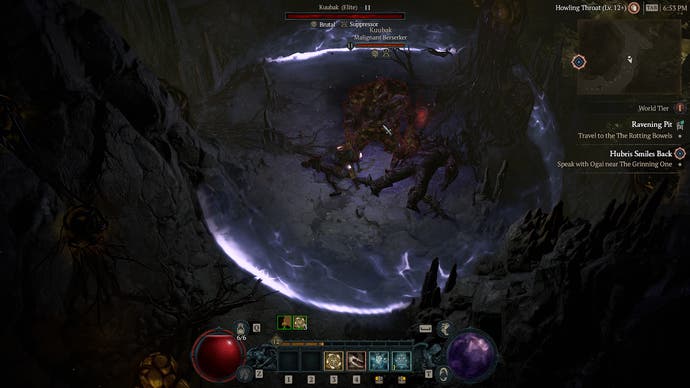
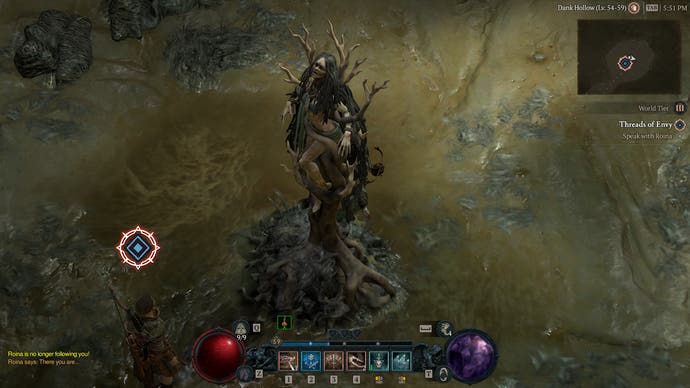
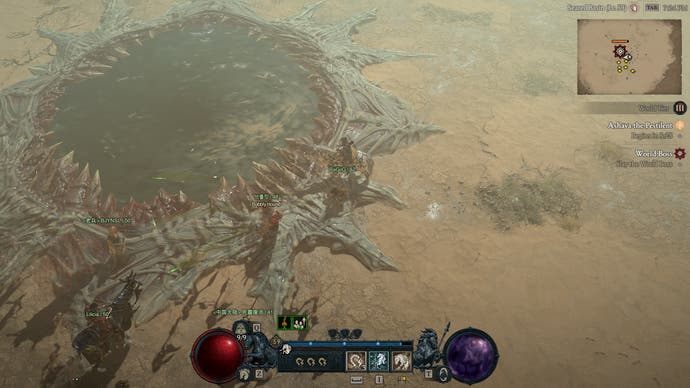
I remind myself, again, that this is barely the middle of season one; I remember relishing every bit of Diablo 3 when it first started rolling out seasons, despite it being the most creatively impoverished instalment in the franchise. The only person I know who isn't fatigued by Diablo 4 right now is a guy whose wife hates video games, and only recently conceded to give him a couple of video game hours at night; he makes every minute of that time count, doing whatever he wants, how he wants, blissfully ignorant of grinding techniques and farming guides or the fact that he'll never figure out the most effective synergies to get to World Tier IV. In short, he's playing the video game as a game to unwind from work - the first video game he's really played in years. This man, for all his limitations, is a galaxy-brained genius experiencing true Diablo immersion.
With my two remaining brain cells, I try to refrain from logging back into the conveyor belt of junky drudgeries that has overwhelmed this lush, gorgeously gothic world. I know some parts of the map now like the back of my hand, and I feel a pleasant familiarity with the land. That I mindlessly power through my silly little video game chores against some of the most beautifully-lit landscapes in the series is a disservice to the environment artists who worked on this for years. Diablo 4 doesn't have to be like this, but truth be told, I am weak and lazy, and the mindless hum of busywork has become a frighteningly easy form of procrastination from actual work. There's a whole decade, at least, of Diablo 4 lined up and waiting for us. But I can't see a future where the long-term player experience gets better without a fundamental change to the way we engage with live-service games, as well as the way live-service games act coy about the compulsive psychology embedded in their design. This may be the most beautiful rendering of Sanctuary yet, but in true human fashion, it's become a hell of my own making.
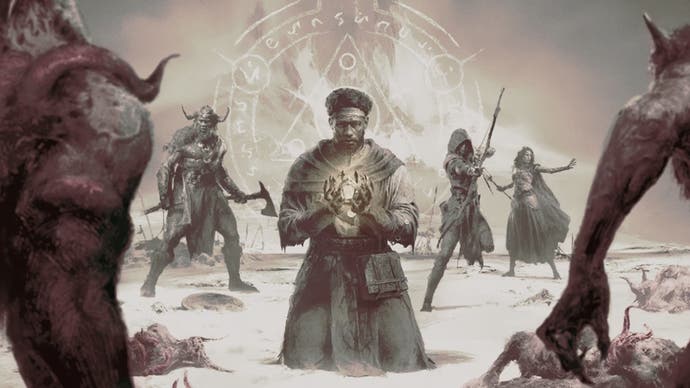










.webp?width=291&height=164&fit=crop&quality=80&format=jpg&auto=webp)